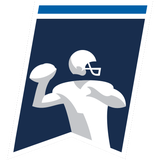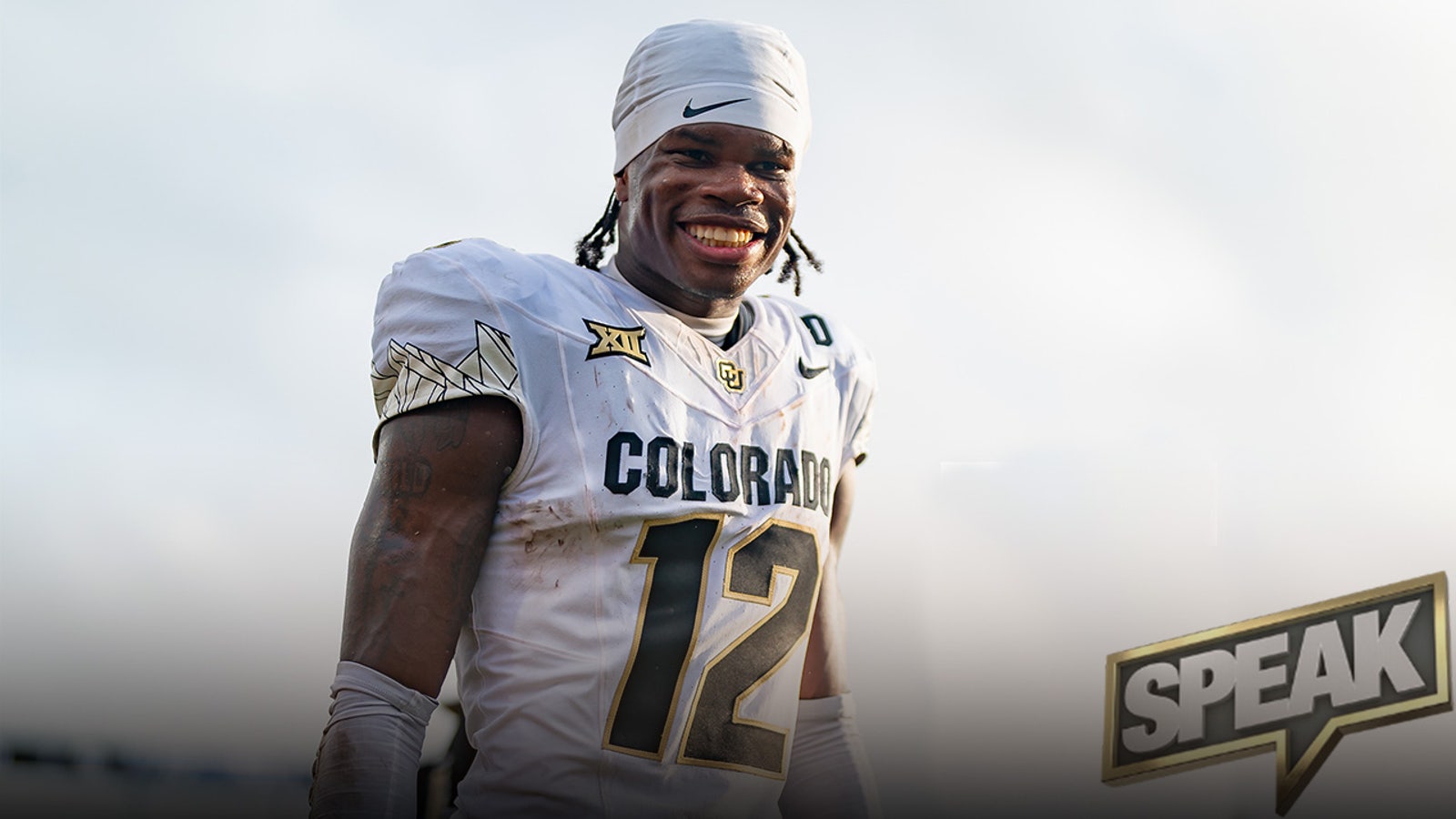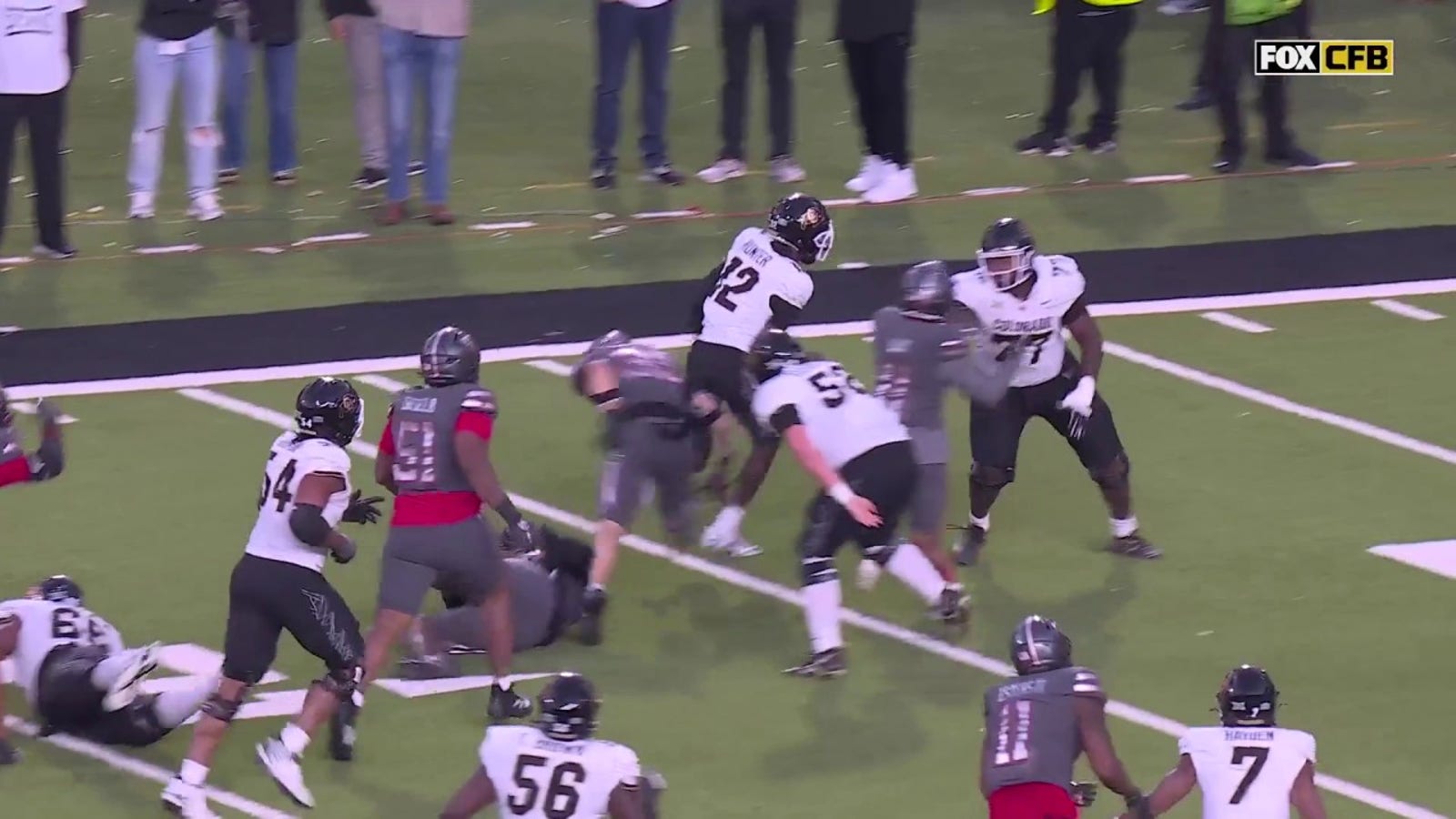
Is Travis Hunter having best season ever for a non-quarterback, non-halfback?
Every once in a while, a star emerges who causes the sports world to stop and pay attention to what they're doing. College football has one of those players right now.
Colorado's Travis Hunter has put up one of the more unique seasons in recent college football history. The two-way star has excelled at both wide receiver and cornerback for the 9-3 Buffaloes, making big plays on both sides of the ball in leading Colorado to a berth in the Alamo Bowl. Earlier this season, Hunter forced the game-sealing fumble to help Colorado secure a win over Baylor in overtime. In Colorado's win over Texas Tech, he had 99 receiving yards and a touchdown.
As Hunter has been a two-way star this season, FOX Sports lead college football analyst Joel Klatt recently argued that he's in a pantheon that's reserved for the best athletes in sports history.
"Travis Hunter is a unicorn," Klatt said on his podcast. "I want to appreciate what he's doing and what we're seeing, because we're never going to see this again. There comes a time when, as a sports fan, you've got to sit back and take stock in what you're witnessing. I think a lot of us do that when we watch LeBron [James] play or those of us that got to watch Michael Jordan play. I'm sure this is how people felt when they watched Mickey Mantle play or how I felt when I got to stand there as a minor league baseball player and watch Barry Bonds taking batting practice or when we watch Tiger Woods hit a golf ball.
"There are things we just know that we aren't going to see again — and this is one of those things. Travis Hunter is one of one."
As a result of his stellar two-way play, Hunter became the betting favorite to win the Heisman. He also made history by becoming the first player to win both the Biletnikoff (best wide receiver) and Bednarik (best defensive player) awards.
"Nobody is doing anything close to what he's doing right now," Klatt said. "He played 170 snaps against Texas Tech. That's absurd! … He is going to win the Heisman if Colorado gets to the Big 12 Championship Game."
Now that he's in the driver's seat to win the Heisman, Hunter has the opportunity to become the seventh non-quarterback, non-halfback to ever win the award. Let's take a look back at the Heisman winners who were not a quarterback or running back and see if Hunter has had the best season of all of them.
Yale end Larry Kelley (1936)
Nearly 90 years before Hunter took the football world by storm due to the number of snaps he played, Kelley did something similar at Yale. In his final season at Yale, Kelley played nearly every minute over its eight games, sitting out just 15 of the 480 minutes that season. He played the entire 60 minutes in six of Yale's games that year.
Kelley's stats might not look overly impressive when viewed through the lens of how the game's played today. But his receiving stats were incredibly impressive for that era, logging 17 receptions for 372 yards and six touchdowns. For reference, his six receiving touchdowns would've been tied for the most in the nation 20 years later in 1956, when the leaders played 10 games.
Like Hunter, Kelley amazed football fans in the 1930s with his athleticism.
"The thing that made (Mr. Kelley) a great athlete was his unusual coordination," the New York Sunday News wrote in a story following his 1936 Heisman-winning season. "His brain is a fire engine, and it drives the splendid chassis of his body smoothly. His reactions are instantaneous. A clear head on a football field is of little use unless the muscles are instantly obedient. He is always there with the sudden dash, the change of pace, the full steam ahead, when it is needed. Like all champions, he is able to do the right thing at the right moment."
That athleticism was on full display during Yale's win over Navy. When Navy had the ball late in that game with the lead, Kelley helped Yale secure a fumble recovery when he kicked the ball several yards down the field before getting the ball. The recovery set up Yale for the game-winning touchdown, and it also caused the NCAA to forbid players from kicking a loose ball.
Kelley's Heisman win was also the most decisive for quite some time, holding the record for the largest Heisman win until Richard Kazmaier's win in 1951.

Yale's Larry Kelley was the second-ever winner of the Heisman Trophy in 1936 (Getty Images).
Notre Dame end Leon Hart (1949)
Hart was arguably the star of Frank Leahy's Notre Dame teams in the late 1940s, helping the Fighting Irish win three national titles during his four seasons at the school. His senior year was his best, winning the Heisman and Maxwell Trophy.
Just like Kelley 13 years before him and Hunter today, Hart was a star on both sides of the ball. He caught 19 passes for 257 yards and five touchdowns, adding 73 rushing yards on end arounds and had three fumble recoveries on defense. He was also Notre Dame's defensive signal-caller that season, helping the Fighting Irish allow just 8.6 points per game.
Hart's dominance transcended college football that year. He won the Associated Press' Male Athlete of the Year Award over MLB star Jackie Robinson and golfer Sam Snead, who won nine PGA tournaments (two majors) that year.
Hart also made history a few months after Notre Dame's 1949 season ended. He became the second of four players to win the Heisman, a college national championship and be selected with the No. 1 overall pick in the NFL Draft all in a year span.

Leon Hart was one of four Notre Dame players to win the Heisman between 1947-56. (Photo by Sporting News via Getty Images/Sporting News via Getty Images via Getty Images)
Notre Dame WR Tim Brown (1987)
As offenses evolved in football, it took some time for another non-quarterback, non-halfback to win the Heisman Trophy again before Brown's victory in 1987. Brown also needed to make contributions in the ground game and as a returner in order to win the prestigious honor that year.
In the passing game, Brown caught 39 passes for 846 yards and three touchdowns. He added 144 yards and a touchdown on the ground. What really seemed to separate Brown from the pack that year, though, was his production as a returner. He had 857 total return yards that season, returning three punts for a touchdown as part of Notre Dame's 8-4 season. Two of those touchdown returns came on back-to-back punt attempts in its win over Michigan State, with both returns going for more than 65 yards.
When the 1987 season ended, Brown was among the top 20 in several stats, such as receiving yards and yards per reception. He was also sixth in all-purpose yards per game (167.9) and second in punt return touchdowns that season. Those stats helped Brown pick up a relatively decisive Heisman win over Syracuse quarterback Don McPherson, winning 45.78% of the possible points.

Tim Brown is Notre Dame's most recent Heisman winner. (Photo by Ronald C. Modra/Sports Illustrated via Getty Images)
Michigan WR Desmond Howard (1991)
It didn't take much longer for another non-quarterback, non-halfback to be named the Heisman winner after Brown's win in 1987. Howard took a similar path to winning the Heisman as Brown, contributing to the receiving, rushing and return games for Michigan in 1991.
However, Howard was even more dominant than Brown was as a receiver. He had 61 receptions for 950 yards and a nation-best 19 touchdowns that year. He also rushed for 165 yards and two touchdowns.
Of course, Howard's most memorable moment that season came in the return game. After returning a kick 93 yards for a touchdown in Michigan's season-opening win over Boston College, Howard returned a punt 93 yards for a touchdown in Michigan's regular-season finale against Ohio State. When Howard found the end zone, he hit the Heisman pose, a celebration that's been recreated by other Heisman contenders — like Hunter did earlier this season.
Howard's dominant season was rewarded with one of the most dominant voting wins in Heisman history. He received 75.5% of the vote share, which was the second-most ever at the time of his win. His margin of victory over second-place finisher Florida State quarterback Casey Weldon was also the largest in Heisman history at the time.
Howard's 1991 season didn't end on too high of a note, though. It fell to Washington in the Rose Bowl as part of its 10-2 season.

Desmond Howard's diving touchdown catch helped seal Michigan's win over Notre Dame in 1991. (Photo by Damian Strohmeyer/Sports Illustrated via Getty Images)
Michigan CB Charles Woodson (1997)
Another non-quarterback, non-halfback Wolverine won the Heisman in one of the most contentious votes in the history of the award just six years after Howard's win. Unlike Howard, though, Woodson did most of his damage on the defensive side of the ball while chipping in on offense and the return game.
In fact, similar to Hunter, Woodson was a dominant two-way player as a high school recruit. He rushed for nearly 4,000 yards as he also played defensive back in high school, with most schools opting to recruit him to play running back in college. Michigan, though, recruited Woodson to play defensive back.
Woodson excelled right away playing defensive back in Ann Arbor as he eventually recorded a seven-interception season in 1997, which was the second-most in the nation. Michigan coach Lloyd Carr eventually made Woodson a two-way player, using him periodically in the 1996 and 1997 seasons. He had 11 receptions for 231 yards and two touchdowns to go with a rushing touchdown.
On top of that, Woodson also made a mark in the return game. He only returned one punt return for a touchdown in the 1997 season, but it came as he displayed his talent in all three facets of the game against Ohio State. He returned a punt for a touchdown, recorded an interception in the end zone and had a 37-yard touchdown grab as part of that win.
Woodson edged Tennessee quarterback Peyton Manning by 9.84% margin in points to win the Heisman in what some viewed as a surprising result at that time. But Woodson's ability to contribute at a high level in all three facets of the game was enough to impress voters and help Michigan go undefeated en route to winning a national title.

Charles Woodson scored two touchdowns in Michigan's win over Ohio State en route to winning the Heisman Trophy in 1997. (Photo by Albert Dickson/Sporting News via Getty Images via Getty Images)
Alabama WR DeVonta Smith (2020)
Quarterbacks have dominated the Heisman conversation for much of the last decade, with a player at that position winning the award all but once since 2016.
Smith offered a reprieve from the quarterback dominance in 2020. But of the six non-quarterback, non-halfbacks to win the award, Smith was the only one who exclusively played one position.
Smith helped make up for that by being much better than his wide receiver counterparts. He led the nation in the big three receiving stats (receptions, receiving yards and receiving touchdowns). His 117 receptions were 31 more than anyone else had that year. Smith had 1,856 receiving yards that year, which was 663 more than what anyone else had in 2020. He also had 23 receiving touchdowns, which was four more than the second-place finisher that season.
To help put Smith's dominant season into even further perspective, he accounted for 41.2% of Mac Jones' passing yards and 56.1% of Jones' touchdown passes that season as the Alabama quarterback finished third in the Heisman vote.

DeVonta Smith had three touchdowns in Alabama's national championship game win over Ohio State in 2020 (Photo by Mike Ehrmann/Getty Images)
How Hunter stacks up entering Week 12
Ahead of Saturday's game against Utah, Hunter might not only be on his way to joining the list of non-quarterbacks and running backs to win the award, but he also might be putting up the best season among any of these players.
Offensively, Hunter has established himself as one of the best receivers in the country. He's seventh in the nation in receptions (69), 12th in receiving yards (856) and tied for sixth in receiving touchdowns (nine), forming a strong tandem with Colorado quarterback Shedeur Sanders.
Defensively, Hunter might be even more impressive. He only has 20 total tackles, two interceptions and a forced fumble, but that might be because quarterbacks don't throw his way often. He's only been targeted 27 times by opposing quarterbacks this season, allowing just 17 receptions for 125 yards and zero touchdowns, per Pro Football Focus.
Of course, Hunter has put up those impressive stats while playing an unprecedented number of snaps on both sides of the ball in the modern era. He's averaging 116 snaps per game, playing 80.9% of Colorado's snaps from scrimmage this season, according to Pro Football Focus.
Maybe Hunter has missed more minutes of game action than Larry Kelley did in his Heisman season, but what the Colorado star has already done this year in a time when players typically specialize in one position, might have already surpassed all the other seasons on this list.
[Want great stories delivered right to your inbox? Create or log in to your FOX Sports account, follow leagues, teams and players to receive a personalized newsletter daily.]












